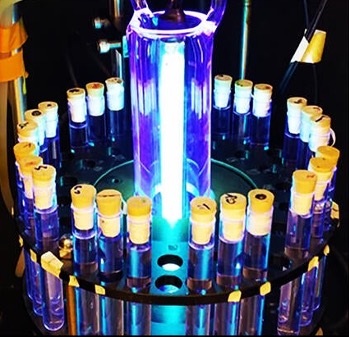Scientists have discovered a new way to break apart 'forever chemicals', the notoriously stubborn pollutants that contaminate our waterways and threaten public health, contributing to a growing list of potential methods of dealing with the long-lived compounds.
News of a simple, low-energy way to degrade some, but not all, forever chemicals came in August from researchers at Northwestern University who described how these tightly bonded, long-chain synthetic chemicals – once thought impossible to degrade without a great deal of energy – 'fell apart' under unexpectedly mild conditions.
Now, a team of scientists at University of California (UC) Riverside have reported an alternative method for supercharging the destruction of PFAS chemicals in water.
It uses UV light and hydrogen gas to break down these harmful substances found in drinking supplies.
Long-lasting PFAS (per- and polyfluoroalkyl substances) were widely used for decades as non-stick and waterproofing agents, where they've found their way into everything from fire-fighting foam to cosmetics. Later nicknamed 'forever chemicals' for the way they persist in the environment, they've been found in concerningly high levels in drinking water around the world and linked to health problems, such as liver cancer.
If this sort of research progress continues, they might finally be coming unstuck.
"The advantage of this technology is that it is very sustainable," says Haizhou Liu, a chemical and environmental engineer at UC Riverside, and senior researcher on the team who developed the new patent-pending process which doesn't generate any undesirable byproducts.
Putting aside regulatory levers that limit the risks of environmental contamination, there are two parts to solving the PFAS problem. The first involves removing the material from environmental resources, such as by filtering drinking water supplies (most often using carbon) – an easier task than cleaning up contaminated soils or groundwater.
The next, and more difficult step, is then disposing of the concentrated PFAS chemicals or destroying them without creating any other harmful substances in the process. PFAS can be burned off at high temperatures, for example, but this is expensive, and incinerating products containing PFAS risks spreading them further.
This is where the new process comes in. It works by bubbling hydrogen gas (H2) through contaminated water to ionize the water molecules (H2O). This generates reactive species including hydrated electrons that then attack the strong bonds holding PFAS chemicals together.
Blasting the water with high-energy, short-wavelength UV light also helps speed up these chemical reactions that have otherwise been too slow to be useful in industrial settings.
So far the researchers have only tested their method on small volumes (500 milliliters or 17 fluid ounces) of tap water spiked with PFOA and PFOS, two types of forever chemicals.
But they have achieved fast and near-complete degradation of the pollutants in these test batches using less electrical energy than earlier attempts.
The double-whammy of hydrogen gas and UV light degraded 95 percent of PFOA and PFOS chemicals within 45 minutes of water treatment, and up to 97 percent overall. But the method still needs some optimizing because even at barely detectable levels PFAS chemicals are dangerous, according to health authorities.

It's not the first time researchers have tried zapping PFAS chemicals to break them. Another team at Clarkson University in New York has been working with the US Air Force to treat PFAS-contaminated water, using plasma reactors and argon gas to split PFAS molecules apart.
Plasma gas is ionized gas made of free-roaming electrons and positive ions. In pilot tests of contaminated water purged from monitoring wells on air force sites, treatment in plasma reactors for up to 50 minutes degraded between 36 and 99 percent of PFAS chemicals, some faster than others.
With a problem this large, we need to consider all options on the table. "The general consensus is that there's not a one-size-fits-all solution" to degrading forever chemicals, chemical engineer Selma Mededovic Thagard of Clarkson University told the American Geophysical Union's Eos magazine.
Liu and his UC Riverside colleagues think they can make their process more energy-efficient too, by testing other low-energy light sources and tinkering with their set-up to enhance the diffusion of hydrogen gas through water.
This will be important if the technology is to stand a chance of scaling up from lab experiments with test tubes to real-world industrial applications, as it has been the major hurdle for other methods.
"We are optimizing it by trying to make this technology versatile for a wide range of PFAS-contaminated source waters," Liu says. "The technology has shown very promising results in the destruction of PFAS in both drinking water and different types of industrial wastewater."
The research was published in Journal of Hazardous Materials Letters.
